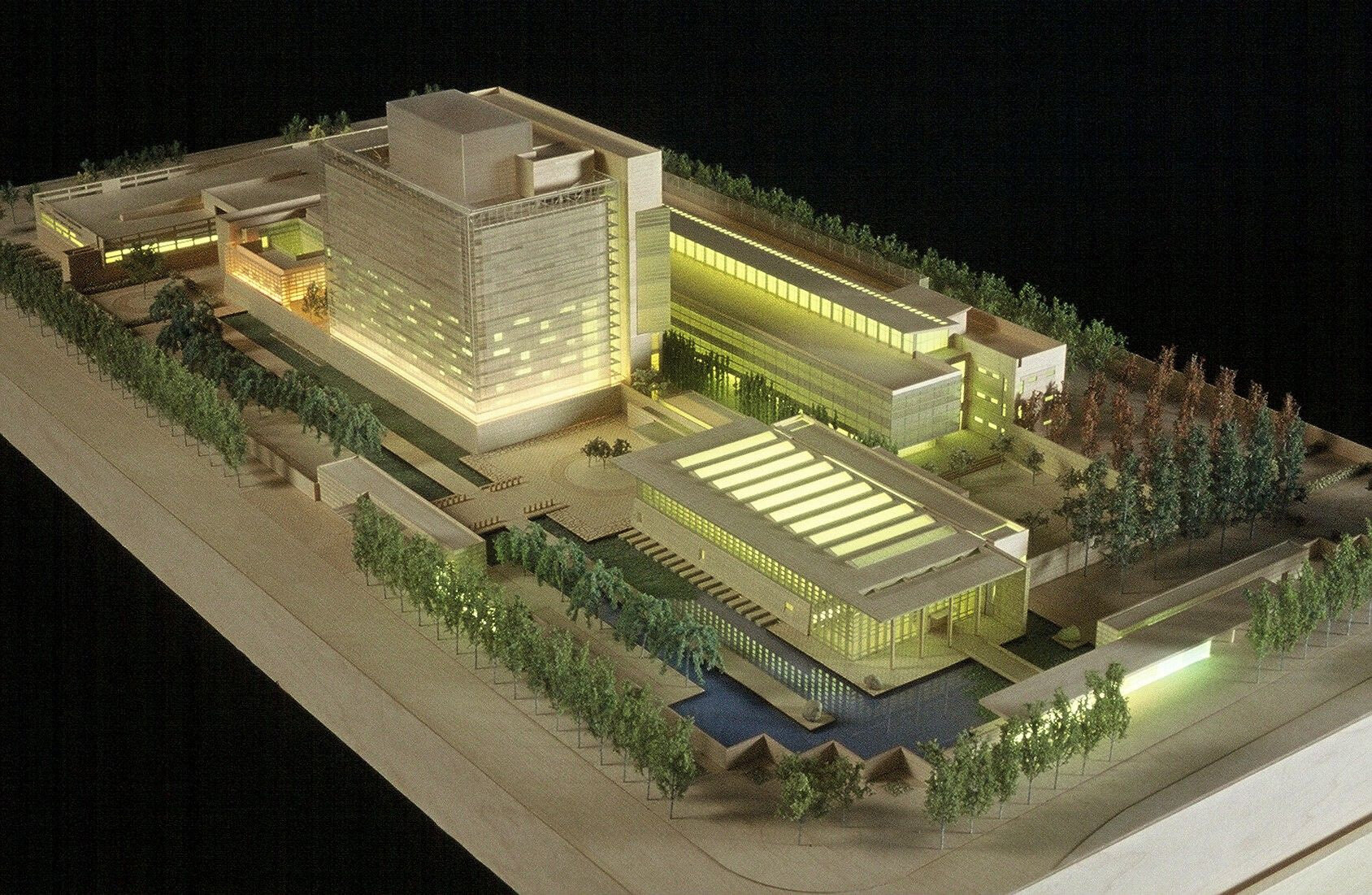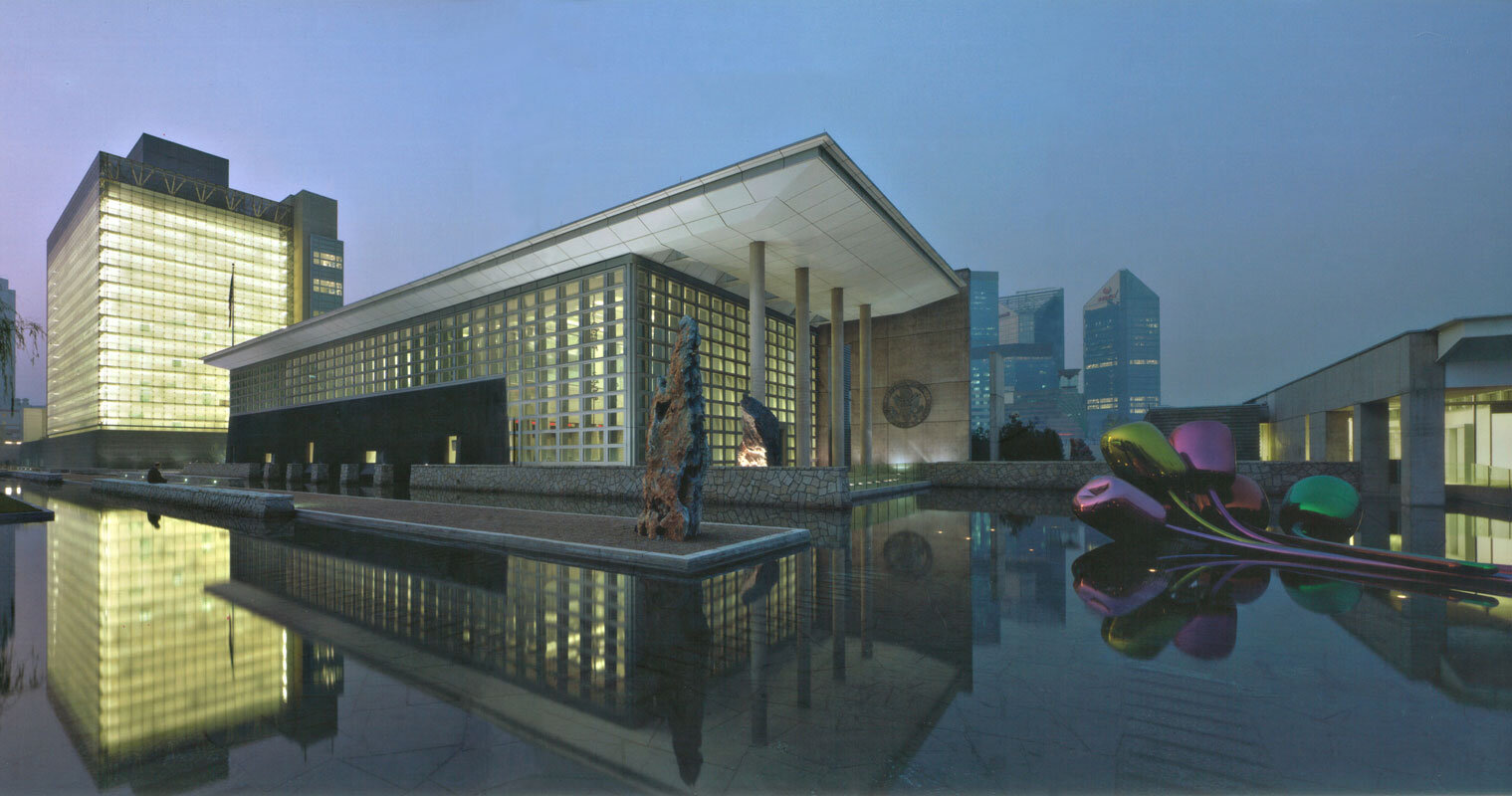
New US Embassy, Beijing, China
Architect - Skidmore Owings & Merrill, San Francisco

Powerful but understated diplomacy
This is the second largest Embassy the United States has ever built, at 500,000 sq. ft, over twice the size of new Embassies in Moscow and Berlin. The size reflects the tremendous importance that China has on US foreign policy and trade. The building was opened in 2008. Ward Sellars led a team of 7 people working out of dedicated project space at Skidmore Owings & Merrill’s premises in San Francisco. The scope of work included Telecommunications, Acoustical and Audiovisual. Project personnel were all required to have Secret or Top Secret clearances, depending on the areas of the building they worked on. Fiber optic cabling to every desk was deemed an essential component of the security concerns for the project.. Due to the extreme security concerns for the project, descriptions of the systems or facilities within the building cannot be disclosed.. It does however represent one of the most complete and complex projects that Ward Sellars has ever designed. Ward and his team finished 100% Construction Documents before he left his SF based firm in the summer of 2003.
SOM leased a floor of an office building near their own premises in downtown SF, as a dedicated project space. The entrance to the office space was an elaborate ‘front’. Signs on the doors and the entire reception area were decorated with names and details for a fictitious Insurance company. Pictures on the walls were of buildings that SOM had designed, but the labels identified them as Insurance ‘clients’. The reception area was completely walled off from the rest of the office floor , with no indication of the design work going on behind. The entire design and sub-consultant team needed to work out of this space - no-one could do any work in their own companies offices or from home or anywhere else, only in this secure work environment. Behind the double card reader controlled doors, with a secure man-trap vestibule, lay a large workspace of about 10,000 sq. ft. Workstations on desks were specially hardened TEMPEST computers, interconnected with optical fibre. The hard-drives for each workstation, were kept inside spin-lock secured file drawers. Each time we arrived for work, we needed to sign a log-book, and open the safes to retrieve the hard-drives. None of the computers on the floor were connected to an external network or the Internet , as per the requirements of the State Departments mandated COMSEC plan. If we needed to do product research on the internet, we went to one of 4 specially installed Internet workstations within a locked room, and we downloaded the material we needed onto writable CD’s. We logged out of the Internet workstations, and took these plastic CD’s to our TEMPEST workstations, where we copied the material to our secure hard-drives. We then had to take the CD immediately to an industrial shredder to be destroyed. Every step had to written into log books.
During the first week of the entire team being on site in the dedicated project space, the FBI came in to give us a briefing on why all of this ‘spy stuff’ was necessary. The FBI first started out by saying that the Communist Chinese Government had a mandate to infiltrate our design team and that they wanted to learn exactly how the building was going together and how they (the CCP) could steal secrets from the new Embassy in Beijing. We were told that each of us on the design team were known to the Chinese government and that we were all being watched by trained agents (otherwise known as Spy’s) living and working in San Francisco. We were told that if anyone, anyone at all, asked us if we were working on the project, we were immediately to ask them their name and why they were asking, and then reporting this to the FBI. The two FBI agents then went on to tell us that the local Chinese staff at the Embassy in Beijing, whom are collectively referred to as FSN’s (Foreign Service Nationals), were all trained Spy’s. That is, every tea lady, gardener, mechanic, secretary and translator were trained Officers in the Foreign Service branch of the Public Security Bureau, and their primary mission was to gather as much information on US government policies and systems as they possibly could. We weren’t really surprised by this, but what the FBI said next, really shocked us. The next two slides of the Powerpoint deck were pictures, the FBI said had been taken within 2 blocks of our current location in SF. The first picture was of a brown UPS truck, and the driver in his brown UPS uniform, leaving the truck. We recognized the photo location as being about a block away from our office location. The FBI said that the man was Colonel Wang, and that he was a US citizen but also a sleeper agent of the CCP, and that he led a team of Chinese agents in SF that were trying to infiltrate our design team. The next slide was of a very attractive early 20’s Chinese girl in hot shorts selling flowers at a flower stall on Market Street, about 2 blocks from our location. The FBI told us her name was Lieutenant Chiang and that she worked for Colonel Wang, and that she too was trying to infiltrate our design team. We were told that she was also a US citizen, but that she had been recruited and trained from an early age.
One of the members of our design team asked the FBI why they didn’t just arrest these Spy’s, if they know so much about them. The FBI were naturally cagey in their reply saying that there were hundreds of CCP agents doing industrial espionage in the SF bay area and that the FBI was tracking each of them. They wouldn’t say more.
A few months into the design work inside this dedicated space, some members of the team needed to visit the existing Embassy in Beijing to interview Post staff and to also look over the site of the proposed new Embassy compound. One of Ward’s Telecommunications designers was tapped to go on this trip. He flew on United to Beijing, and checked into a standard 3 star Hotel, with reservations made personally on Hotel.com . He was travelling alone, as we had been told by the FBI to make separate travel arrangements and that we could not fly or take taxi’s with other members of the delegation. He was entering China on a Tourist visa. Only Ward, SOM , the State Department staff in the US and the FBI knew of these travel plans, or so we thought. This guy, we will call him George, arrived in Beijing and hailed a Cab from the cab rank, on his own. The taxi driver started chatting to George in pretty good English, which George knew to be odd. The taxi driver asked him what he was doing in Beijing and George said “sight-seeing”. George asked the Taxi driver to drive down a certain road on the way to the Hotel. The Taxi driver then asked “Oh, you mean the location of the new US Embassy Building?”. It had not been reported anywhere the location of the new Embassy at that time, not in the US and not in China. George did not reply to this comment, but he immediately knew that the Taxi Driver was a Government Agent and that he had been followed all the way from the US. George checked into the Hotel and was assigned a room. As he took a shower after the long trip, he left the door of the bathroom open, hot steam billowing out of the bathroom. When George stepped out in his towel, he noticed that a small part of the hallway mirror had not fogged up from the steam. After getting dressed, George investigated the mirror and found a surveillance camera and microphone behind it. So the Chinese government had arranged everything to spy on George, they knew his Flight reservations, the Hotel reservations, the Taxi Driver, the Hotel room, the surveillance - each was a small part of the enormous Chinese Communist establishment that employs over 20 million agents/fixers/sympathizers around the world.
The work at the Embassy in Beijing by the US Government is meant to counteract this powerful police state. Ward’s teams work remained secure and out of reach of these agents.
Unfortunately, there were precedents of Security breaches at previous US Embassy projects, the most notorious being the Moscow Embassy which was bugged by KGB agents and could not be ‘cleaned’. There are numerous stories and articles about this saga that lasted 27 years until the Embassy building could be torn down, before ever being occupied. It was finally re-built with imported US materials and constructed by US Workers with Secret clearances. Ward’s team were told about the State Departments practice of ‘random procurement’. Foreign Building Operations (FBO) staff in the DC area, would go to Lowes or Home Depot on their weekends and buy some plywood or sheet rock or electrical cabling, for a ‘home renovation’, using their personal credit cards. These staff would then drive these materials in their personal vehicles to an unmarked building in the Virginia countryside where they would be unloaded, without words being spoken. The staff inside these warehouses would amass enough materials from many such small purchases, into shipping containers. They would then be sent on a circuitous route to many ports, before being offloaded in the port closest to the new Post in a foreign country. The locked and sealed containers would be escorted by US staff to a warehouse controlled by the US Government approved US contractor for the project. No local workers were ever in the proximity of these materials. The intent of these precautions is to forestall the knowledge of where Embassy or Consulate materials are coming from, reducing the chance that ‘bugs’ could be inserted into them. Even so, every piece of material imported from the US is 100% X-rayed and RF scanned before being installed into the building.
US Embassy, Beijing, China -Interior of Public Atrium

